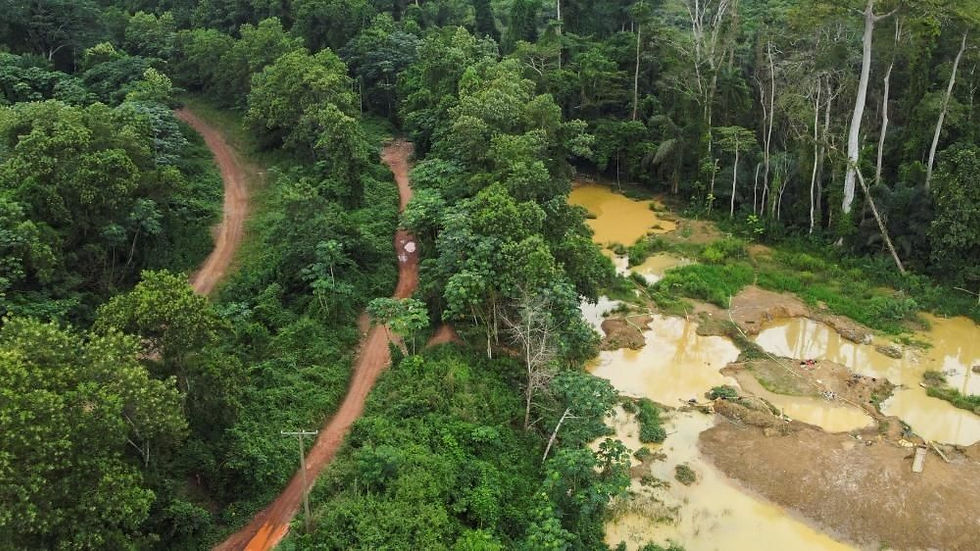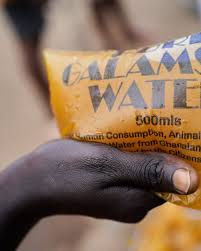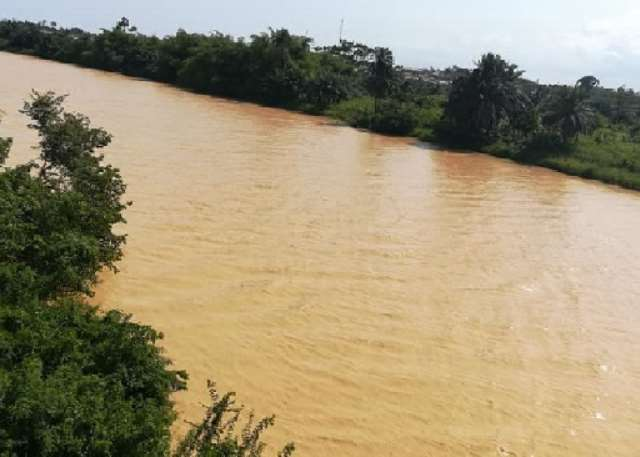DO YOU KNOW ILLEGAL MINING (GALAMSEY) IS A THREAT TO FOOD SAFETY AND SECURITY
- Hawa Issaka
- Dec 7, 2024
- 7 min read
Updated: Dec 10, 2024

What is illegal mining (Galamsey)?
Galamsey is the term used to describe illegal small scale mining in Ghana, especially for gold. The phrase "gather them and sell" in English is the source of the word. In the past, it refers to Ghana's traditional small scale mining methods, in which residents came together and filtered through rivers and streams in search of gold. In Ghana, there have been discussions over the elevated incidence of Galamsey. It is a rapidly expanding problem found in many nations with underground mineral riches. Governmental organizations, the commercial sector and local community leaders are now very concerned about Galamsey (Ghana Web).
Before the arrival of colonial explorers on the Gold Coast, Ghanaians engaged in small-scale indigenous mining, or "Galamsey," as a widespread rural survival activity. Galamsey has been significantly associated with negative effects on the environment and human health because of the generally crude methods used (Nyantakyi-Frimpong et al., 2023).
Ghana has an abundance of agricultural and mineral resources. The largest mineral resource reserves are found in the areas that make up the main agro-ecological regions. Ghana's food security is at risk due to the destruction of farmland in the agro-ecological zones caused by illegal small-scale gold mining, Galamsey (Gilbert and Albert, 2016). Because Galamsey releases harmful chemicals like cyanide and mercury into the environment, it poses a serious risk to food safety. The food chain is negatively impacted by these chemicals' contamination of rivers, streams and agricultural areas. Heavy metals like arsenic, lead, and mercury are absorbed by crops produced in contaminated soils and build up in edible sections, rendering them unfit for human consumption. There are serious health hazards associated with this contamination, such as cancer, organ damage, and neurological issues. Toxins are introduced into farmlands by the frequent use of contaminated water bodies for irrigation. Communities that depend on fish as a source of protein may be at risk as a result of the accumulation of certain heavy metals by fish in polluted waterways. Immune systems can be weakened by these poisons, particularly in pregnant women and children (Nyantakyi-Frimpong et al., 2023).
How does Galamsey impact the environment?
The environment is unquestionably the biggest victim of Ghana's illegal small scale gold mining industry. The effects of Galamsey on the environment are widely known in Ghana. These include air pollution, heavy metal contamination of soils and water, land degradation and extinction of plants and animals (Gilbert and Albert, 2016). Galamsey has devastating impacts on the ecosystem. It often involves deforestation, which disturbs the natural balance and results in the loss of vital wildlife habitat. Furthermore, about 60% of water bodies in Ghanaian mining districts are affected by the contamination of soil, water bodies, and aquatic ecosystems caused by the use of hazardous chemicals, particularly mercury, to extract gold from ore. The livelihoods of local residents that rely on agriculture and clean water are at risk because of this contamination. Studies suggest that illicit mining has ruined over 19,000 hectares of cocoa fields, which has an impact on Ghana's economy.
It is widely acknowledged that uncontrolled digging and the degradation of rich topsoil caused by small-scale mining specifically harm agricultural regions. In the process, water bodies are also ruined by silting or contaminated or polluted with chemicals (like cyanide) that make them unfit for home and agricultural usage (Nyantakyi-Frimpong et al., 2023). Because of spills and leaks, illegal mining operations cause the release of harmful petroleum hydrocarbons, such as fuel oils and grease. Hydrocarbons are included in scrap, wastewater and other waste products produced by mining operations. Methane and volatile organic carbons (VOCs) like benzene, toluene, ethylbenzene, and xylene are the most abundant hydrocarbons from illegal mining operations. Ammonium nitrate and other blasting agents are the main way that nitrate, a common pollutant in Galamsey activities, enters the environment. Nitrate compounds are generated during these Galamsey events and have the ability to quickly enter nearby water bodies (Awewomom et al., 2024).
How does Galamsey threaten food safety and security?
Illegal small-scale gold mining In Ghana has a serious negative influence on food safety because it destroys cropland in the main agricultural zones, which lowers crop production and ultimately threatens the nation's food security. This is among the major elements posing a threat to Ghana's supply of wholesome food. Galamsey's degradation of cropland in agricultural areas has a direct impact on food production, endangering the nation's food security and safety(Gilbert and Albert, 2016). Chemical contamination of soils and water is one major manner in which Galamsey compromises food safety. Commonly used hazardous materials in mining operations, such cyanide and mercury, seep into neighboring farmlands and waterways. Heavy metals are absorbed by crops produced on these polluted soils and build up in edible parts like grains, fruits, and vegetables. These toxins can cause major health problems, such as cancer, kidney failure, and neurological abnormalities, when they are eaten. These pollutants are also accumulated by fish and other aquatic food supplies from contaminated water bodies, presenting further health hazards to nearby communities that depend on these resources for survival.

Galamsey can negatively impact the food and nutrition security of households in a number of ways. First, production from agriculture may be lowered if a sizable portion of farmers spend time away from farming. Young children may be exposed to less-than-ideal childcare and nourishment when women, who are usually the primary caretakers in the majority of Ghanaian households, are strongly involved in Galamsey(Nyantakyi-Frimpong et al., 2023).
(Gilbert and Albert, 2016) employed secondary data, including Ghana's agricultural productivity records, consumer price indices of food commodities and national food import statistics, to analyze the effects of illegal small scale gold mining in Ghana through the lens of a theory that links Galamsey and agricultural productivity in terms of the realistic threat to food security. According to the data, over the past few years, the major Galamsey regions, the Ashanti, Brong Ahafo, Eastern, Central and Western have shown steadily declining food output and rising Consumer Price Indices relative to the national averages (beginning in 2012).
Ultimately, Galamsey compromises the safety and availability of food in Ghana by polluting ecosystems, reducing farming land, and creating socioeconomic pressures that affect household-level nutrition. The combined effects on food quality, accessibility, and affordability threaten both the short- and long-term stability of food systems in Galamsey-impacted regions.
What are the health implications of Galamsey?
Ghana's uncontrolled, unskilled small-scale gold mining is linked to a number of harmful health outcomes, including birth defects, disorders of the brain, heart diseases and breathing troubles. Since mercury is a heavy metal that is frequently used to extract gold from mining and is associated with a number of health hazards, its application in Galamsey operations adds to these health effects. The health implications of Galamsey stem primarily from the toxic chemicals it introduces into the environment, particularly mercury and cyanide, which ultimately find their way into the human body through contaminated food, water and air. Mercury, one of the most commonly used substances in illegal gold extraction, is highly toxic and accumulates in the environment and the human body. When ingested through food grown in polluted soils or fish from contaminated water bodies, mercury binds to proteins in the body, disrupting enzyme function and causing oxidative stress. In the brain, mercury damages neurons, leading to cognitive impairments, memory loss and developmental delays in children.

Pregnant women exposed to mercury risk passing it to their unborn babies, potentially causing birth defects, low birth weight, or delayed neurological development in infants. Cyanide, another chemical used in mining, inhibits cellular respiration by binding to enzymes necessary for oxygen use, leading to dizziness, shortness of breath, and in severe cases, heart or respiratory failure. Long-term exposure to heavy metals like lead and arsenic, also present in polluted soils and water, can cause chronic diseases, including cardiovascular disorders, kidney damage and cancers. These toxins also weaken the immune system, making individuals more susceptible to infections. The inhalation of fine particulate matter and volatile organic compounds (VOCs) released during mining further exacerbates respiratory problems, leading to conditions like asthma, bronchitis, and even lung cancer. Over time, the bioaccumulation of these harmful substances in the body results in widespread organ damage, reduced quality of life and increased mortality, making Galamsey a severe public health crisis in affected communities.
What can be done to address the issue?
There are several ways to deal with the problem of Galamsey. Illegal mining operations can be identified and tracked with the use of drones and satellite photography, and reporting can be made easier with the use of mobile apps. It is essential to promote legislative and policy changes that address the underlying causes of Galamsey, such as unemployment and poverty. Supporting laws that encourage small-scale mining is part of this. Initiatives such as Stop Galamsey adopt an extensive approach that tackles the underlying causes of the problem in addition to the problems produced by Galamsey, promoting environmental stewardship and long-term development. The severity of pollution levels and the related health crises caused by Galamsey have drawn national attention, and securing a sustainable future for future generations requires a committed and dedicated effort.

Addressing the impacts of Galamsey on food safety and security requires a multifaceted approach that combines enforcement, education and restoration. First, stricter enforcement of mining regulations is crucial. Government agencies must intensify efforts to monitor and shut down illegal mining activities, particularly in agricultural zones, while holding offenders accountable through hefty penalties. Additionally, reclaiming and rehabilitating degraded lands should be a priority. Contaminated soils can be treated, and mining pits filled to restore farm land for farming.
Public education campaigns are also vital in raising awareness about the dangers of Galamsey to food safety and encouraging communities to adopt alternative livelihoods such as sustainable farming. Providing technical and financial support to small-scale farmers can help boost agricultural productivity and reduce the economic lure of illegal mining.
Finally, investment in research and infrastructure to improve food testing and monitoring systems can ensure that contaminated food does not reach consumers. Collaborative efforts between the government, private sector and local communities are essential to develop sustainable solutions that safeguard Ghana’s food systems while protecting both the environment and public health.
In conclusion, Galamsey poses a grave threat to Ghana’s food safety and security, with far-reaching consequences for public health, agricultural productivity and environmental sustainability. The contamination of soils, water bodies and crops with toxic chemicals like mercury and cyanide directly endangers the quality and safety of food, while the destruction of farmland reduces food availability, driving up costs and exacerbating food insecurity. To address this crisis, immediate action is needed to enforce mining regulations, restore degraded lands, and promote alternative livelihoods. Public education and investment in food monitoring systems are also crucial to safeguarding food safety. By prioritizing these measures, Ghana can protect its agricultural resources, secure its food systems and ensure a healthier future for its people.
References
Awewomom, J. et al. (2024) ‘A review of health hazards associated with exposure to galamsey-related pollutants’, Health Sciences Investigations Journal, 5(2), pp. 726–734. Available at: https://doi.org/10.46829/hsijournal.2024.6.5.2.726-734.
Gilbert, D. and Albert, O.-B. (2016) ‘Illegal Small-Scale Gold Mining in Ghana: A Threat to Food Security’, Journal of Food Security, 4(5), pp. 112–119. Available at: https://doi.org/10.12691/jfs-4-5-2.
Nyantakyi-Frimpong, H. et al. (2023) ‘“Now We’Ve All Turned To Eating Processed Foods”: a Photovoice Study of the Food and Nutrition Security Implications of “Galamsey” in Ghana’, African Journal of Food, Agriculture, Nutrition and Development, 23(1), pp. 22200–22220. Available at: https://doi.org/10.18697/ajfand.116.22855.


Comments